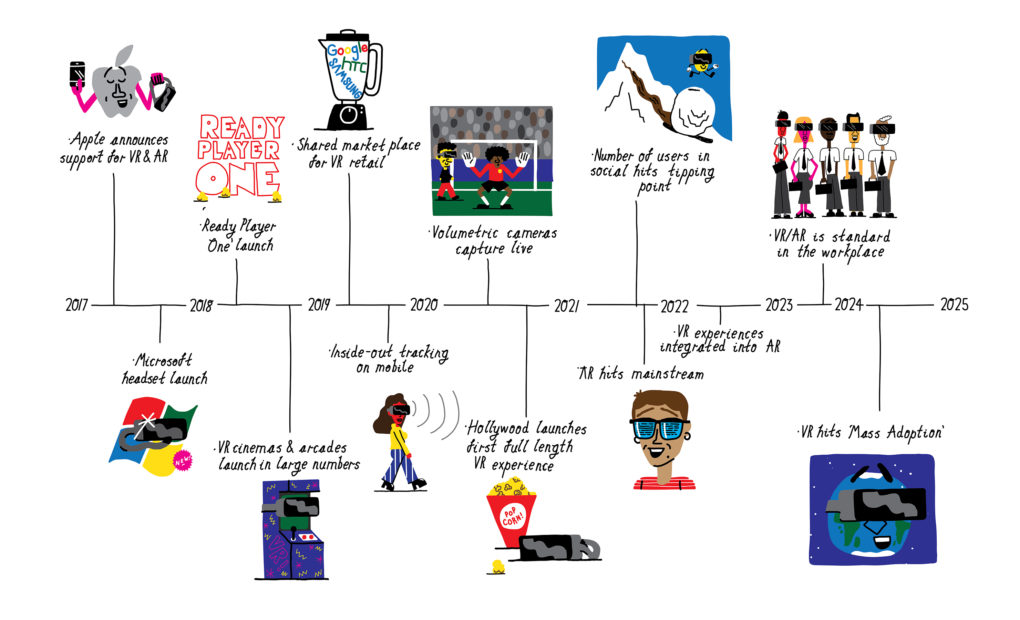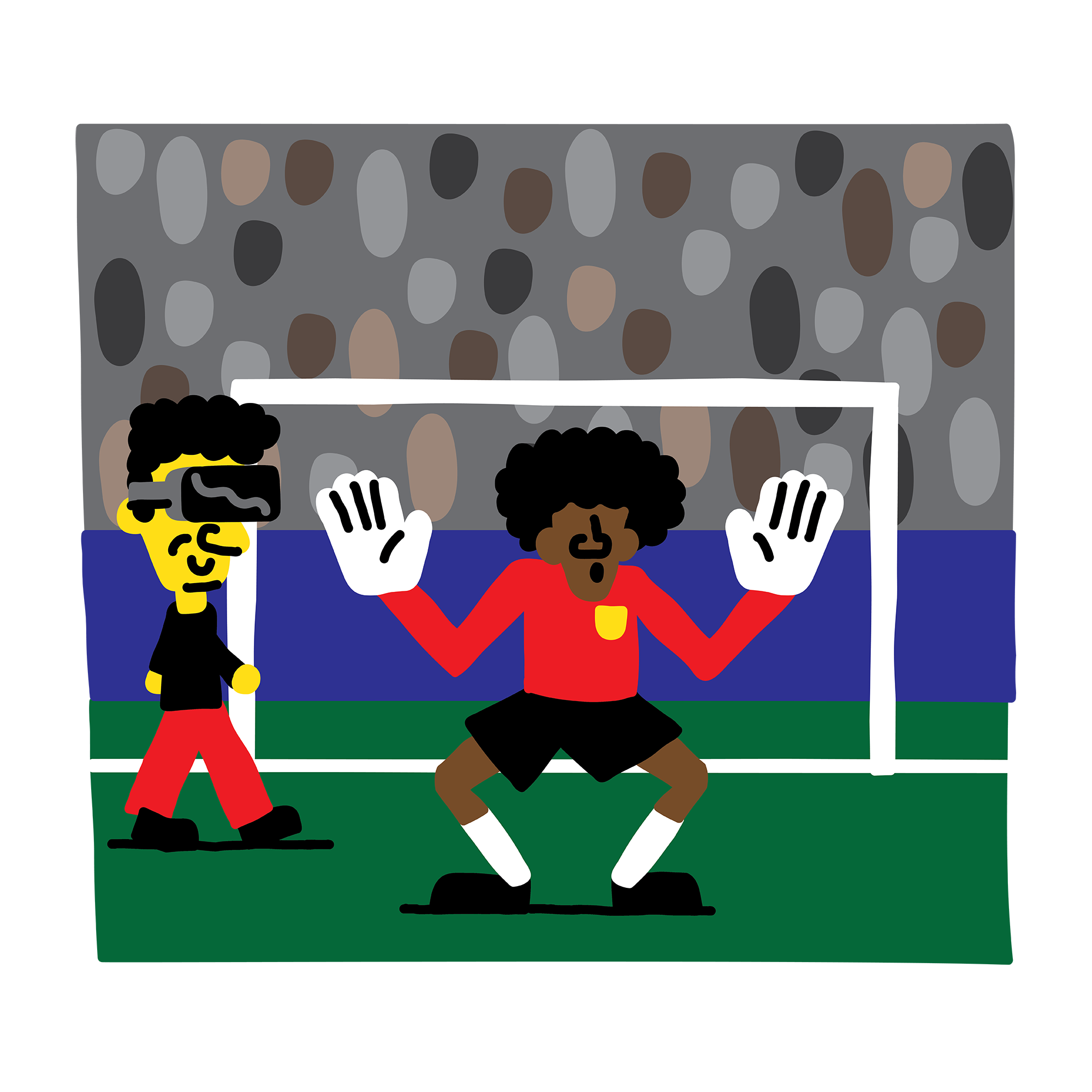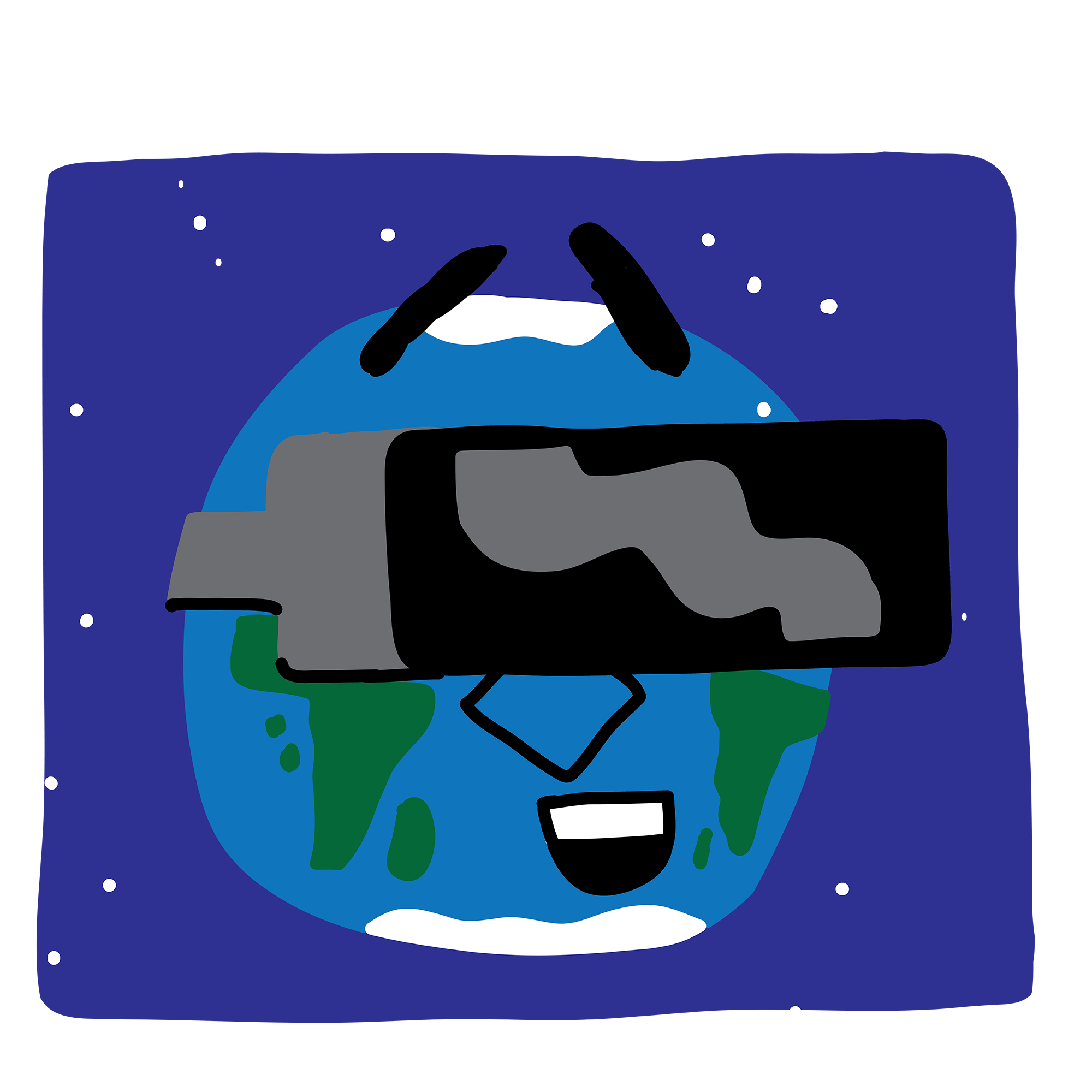
The Route to Mass Adoption
When you try VR now, quite honestly, it may be hard to see how this medium is touted to be bigger than TV by 2025 (Goldman Sachs). It isolates you from the people right next to you, it’s expensive and it’s out there in relatively small numbers. However, this is all going to change. Not over night, but gradually.
There’s a huge expectation and impatience for VR to be the next big thing right now. However, it’s been dawning on people that this uptake is going to take longer than originally expected. The technology is still in it’s infancy, at a stage we’ll find laughably clunky in the future, exactly like the first mobile phones with giant car batteries.
So, without further ado, here are the factors which I think will contribute to the mass adoption of VR…
[If you’re more of a video person, you can watch me give a talk on this exact topic here]

Apple and Microsoft
Sitting in the VR wings for a while, Apple have finally committed to supporting VR, and with quite a fanfare. Next up, the biggest single platform in the world – Windows. Microsoft see a big gap in the market for affordable VR headset and are partnering with the likes of Asus and Dell to create these, starting at £250. These are expected in Autumn 2017.

Gaming
Often touted as the key driver in mass adoption of VR, I disagree. Whilst important, I actually think it’s part to play is smaller than cinematic VR. Last year Samsung made public their figures that 50% of the content viewed on their headsets is gaming, and 50% 360 video. According to Armando Kirwin, in his brilliant series on VR, the figure for gaming is now actually lower – around 35%, a trend that I see continuing in favour of 360 films and experiences.
One of the most important aspects of gaming VR though is it’s multiplayer ability – making VR social – something I’ll come on to in more detail and one of the most vital parts to the route. Allowing people to communicate and play together, virtually, takes away one of VR’s biggest achilles heels – isolation. You’re still isolated from the real world but you’ll be so deeply connected to other players that the collaboration and sense of camaraderie created will be deeply memorable.

Cost
Right now, high end VR headsets are too expensive, an HTC Vive is £750, a computer to run it is minimum £1000, putting it out of reach of the vast majority of potential users. Playstation VR is more reachable, if you look at the additional cost to a user with a Playstation, it’s £350, still a lot though.
For mass adoption VR needs to be far cheaper – in the realms of the Google Daydream and Gear VR, this is never going to happen to a tethered system like Oculus, HTC Vive or playstation – we need to look to mobile.

Mobile
For VR to reach the masses it has to be on mobile. Phones will continue to get more powerful, to the point that they are good enough to deliver high end, interactive VR experiences and volumetric content. For this, the phones need to be able to track their environment, allowing users to walk around the physical and virtual space, just like on the Vive now. This ‘inside out’ tracking is what is used on project Tango and is currently unique to only a couple of extremely powerful handsets. Spending <£100 on a VR headset as an addition to an existing device like a phone is a way that we are going to encourage mass adoption.

Augmented Reality
Augmented reality is coming back and it’s going to stay, in a big way. It had a stuttering start with Google Glass but the next generation of glasses will allow people huge advantages to everyday work and life. If you’ve not seen Keiichi Matsuda’s Hyper Reality then you should watch it now. Although frankly terrifying, it brilliantly illustrates how AR could work.
Like it or not, this kind of technology will be prolific and very quickly so. AR will have a smartphone-like take up, getting millions of people accustomed to using wearable screens. This is going to be huge for VR – these same headsets/glasses will allow VR content to be played. It won’t look as good on AR headsets – you’ll see the real world at the peripherals of your vision – but it will be so easy to do. People won’t need to put headsets on to view VR, they will already be wearing headsets, a massive change.

Cinematic VR
There has been a messy, and entirely pointless argument about whether 360 video is VR. The pedants argue that it’s not, and by the dictionary definition they may be right. As far as I’m concerned, who cares. I can watch a 360 video in a VR headset and get as much pleasure & value from it as if I am playing a game. We watch films on our iPads, as well as playing games and other applications, so why does anyone care if we watch 360 videos in a headset?!
Hollywood is experimenting with 360 content too. Titles including Wild, Jurassic Park, Jungle Book, the Martian have VR taster experiences. Alejandro González Iñárritu, director of the Revenant (and a host of other top Hollywood films), has recently launched a VR experience at Cannes which goes beyond a simple 360 video and allows you to walk around a physical space as part of the film. By doing so it ceases to be a film and moves into the realm of an experience, blurring the lines between 360 and VR.

‘Experience’
Iñárritu’s experience shows a glimpse of what will be possible in the future in VR and the breadth of possibility in this new medium. As filmmakers we need to open our minds from the simple linear track of narrative and into the broader world of choice and experience. The richness and immersiveness of what can be created will be a huge driver to adoption. You can watch a film, but you actually take part in an experience.

Ready Player One
A book by Ernest Cline about a dystopian future where people escape reality into a magical and boundaryless ‘metaverse’ has been essential reading for those of us in the industry for a few years. Ready Player One is being made into a film by Steven Spielberg, set for release in spring 2018. It’s going to be a huge title with a massive launch and accompanying VR experiences.
I think this title is going to singlehandedly have a massive impact on adoption in VR – mainly because it exposes the potential, sense of magic and also practical range of ways that VR can be used in the future.

Live
The ability to watch a gig or a sports event live in VR is a fantastic pull to potential VR recruits. To date, the quality of this experience has been lacking, due in equal part to the speed of internet connections and the quality and reliability of the technology involved in streaming. This is all changing fast though and there are a number of out of the box live streaming solutions, including the Orah 4i, simpler systems like the Ricoh Theta and Samsung Gear 360. All of these systems now stream live to YouTube and Facebook in 360, removing a big technological barrier to streaming – distribution.
Streaming in 360 is one thing, it’s going to allow people those money-can’t-buy-experiences, backstage, on stage, courtside etc but things will get really amazing as the technology keeps evolving. As volumetric capture develops we will be able to live stream events in a way that will allow the viewer to actually walk around and explore the experience – really rivalling, and perhaps exceeding, the real thing.

Retail
I did a talk for Wired a couple of years ago on the future of VR in retail. I still feel like this will be one of the biggest aspects of the future of VR, both from a revenue generation perspective and also from a popularity and practicality perspective. Already automotive marques such as Audi have been grasping the potential of VR to sell their cars and Thomas Cook have also seen massive ROI on using VR in retail, selling 190% more holidays when they use it. I recently wrote an article about ROI in VR here.
People will be inspired to buy into VR if they think they can have shopping experiences that are better than they can online or even in person. You can’t instantly change the colour of the car in front of you, or try different wheels in the real world, at the click of a button. Sure, there’s a lot that’s never going to be as good as the real thing, but there is so much time you can save and so much iteration of choice you can have in the virtual world.

‘VRcades’
Hugely successful already in China and growing fast in the US – VRcades where people pay for a VR experience in high footfall locations are going to be a great way of onboarding new users. HTC have a licensing model for this already, expect other manufacturers to follow.

B2B
Whilst not the glittery front page of companies’ communications, there will be a huge number of B2B virtual reality applications emerging. Training in VR is already proving itself strongly, saving companies cash and improving engagement of staff being trained. Companies will also increasingly use VR for design, collaboration, and education. Whilst not a big driver in adoption, it will certainly help drive awareness.

Social
Facebook sees VR not as isolating, as it may fairly be seen now, but as one of the biggest social enablers the world will know. What Zuckerberg has been very smart to identify is that people will be able to play, meet, communicate, work, learn and more in the virtual world. Right now, it may seem strange to talk to people as avatars in a virtual space, but it’s amazing how quickly you forget it’s not a real person. Emotion and expression come across surprisingly well with clever movements of mouths and expressive, if cartoon like, faces. This Engadget review of Facebook Spaces helps to explain the feeling of social VR.
In conclusion…
As the technology improves, so will the capabilities and potential of VR content that can be viewed in headsets. We’re not only discovering how to make better experiences but also how to create completely new experiences. Right now, we don’t even know what we will be able to access or do in the virtual world of the future, but here’s the thing, there are no limits.
You will be able to travel to the moon, explore deep sea wrecks, visit zoos of extinct animals (or dinosaurs!), collaborate on projects virtually at work, learn about geology from the summit of Everest, watch Wimbledon live from the umpire’s chair, watch sport from the pitch itself, moving unseen amongst the players & even be part of a zombie film. You’ll be able to operate as a surgeon, collaborate in construction, virtually network and so much more in B2B. As the technology improves, these experiences are going to feel more real, more magical and provide far more value.

Thanks to Tom Slater for the awesome illustrations

Comments
Responses
Chris McKeeman says
Well said Henry
FirstJessika says
I see you don't monetize your site, don't waste your
traffic, you can earn extra cash every month because you've got
high quality content. If you want to know how to make extra bucks, search for: Mrdalekjd
methods for $$$